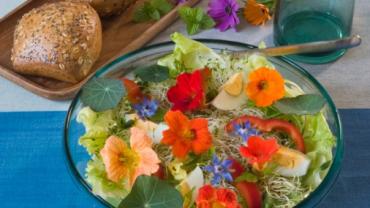
Valentine’s Day is one of the most popular days of the year for flower sales. Bouquets of roses lilies gerbera daisies baby’s breath and more fly out of florists’ shops bringing smiles and feelings of love and appreciation to their recipients. But flowers do more than just look pretty and give off nice aromas. Whether they’re made into teas sprinkled on salads or used in other culinary applications edible flowers supply meals with beauty and nutrients.
One edible flower is nasturtium. Nasturtium flowers are brightly colored and all parts of the plant can be eaten: the petals leaves and stems. The stems start out with a slightly sweet taste but a peppery heat soon takes over. In fact the name nasturtium which means “nose-twister” comes from the peppery zing which is reminiscent of watercress—botanical name Nasturtium officinale. However even though watercress has “nasturtium” in its scientific name it is related to the flowering nasturtiums only at a higher level of classification; they belong to different families genus and species.
The most common culinary application for nasturtium flowers is as an ornamental—but edible—decoration in salads. Other ways to prepare them include stir-frying and horticultural experts also suggest stuffing them with a filling like grape leaves. The flowers can be stuffed as well similar to a common preparation for squash blossoms. Plus the green unripe seed pods can be pickled and used as a substitute for capers. As if those weren’t enough interesting ways to use this plant in the kitchen the leaves and flowers can be made into pesto which according to Martha Stewart makes a great garnish for nasturtium risotto. As for their nutrient content nasturtium flowers provide vitamin C and lutein plus small amounts of zeaxanthin and β-carotene.
The compound in nasturtium primarily responsible for its peppery zing is a volatile mustard oil benzyl isothiocyanate. Its ability to affect mucosal membranes and certain types of bacteria underlie the traditional use of nasturtium in herbal medicine as an expectorant and antibiotic as well as a remedy for respiratory ailments and urinary tract infections.
Another pretty flowering plant that has culinary uses is lavender. Dried lavender flowers are often included in blends for herbs de Provence which can be used in any number of savory dishes for meat and vegetables alike. The more common application for lavender flowers however is in sweet dishes such as lavender shortbread cookies lavender ice cream and even a lavender-chamomile tequila cocktail. It’s important however to buy culinary lavender as ornamental lavender may not be suitable for consumption.
Lavender flowers have a lovely purple color and just as with nasturtium they aren’t only nice to look at. Lavender has been employed for centuries as an anxiolytic—meaning it helps people find calm. Compounds in lavender essential oil (LvEO) may help elevate serotonin levels in the brain while decreasing their turnover rate. (Many antidepressant medications work via a similar mechanism.) LvEO is typically used in aromatherapy applications but research in mice indicates that the olfactory route (being able to smell) is not actually required in order for LvEO to be effective. The anti-anxiety and calming effects occur even in mice who have had their sense of smell chemically removed. Studies suggest that LvEO may help patients remain calm before dental examinations and perhaps this might apply to medical office visits in general.
Other uses for edible flowers their oils and extracts are endless. For example rosewater made by distilling rose petals is a common ingredient in Middle Eastern and North African dishes. Rose petals are also edible but the object of your affection will probably appreciate them much more in a vase than on a plate!
Sources